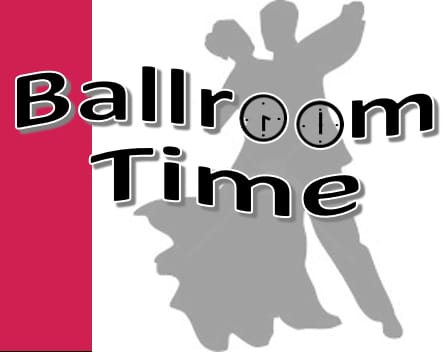|
| Question: What exactly is Ballroom Dancing? |
| |
| The general term “Ballroom Dance” can be applied to a wide variety of couple dances practiced to various types of music, rhythms, styles, and tempos and in various settings from social to showcase to competition. Ballroom Time focuses on social and showcase, not competition. Everything from salsa to nightclub two-step to West-coast swing to disco dancing can be considered to fall under the general term Ballroom Dance. However, over the generations a core group of dances has become more formally associated with the term. These dances have a written syllabus prepared by experts in the dance detailing how steps and figures should be performed. There is a formal American style and a formal International style. And each syllabus has increasing levels of difficulty from bronze to silver to gold. Dances associated with this more formal term “Ballroom Dance” include foxtrot, slow waltz, ballroom tango, quickstep, Viennese waltz, cha-cha, samba, rumba, mambo (paso doble in some regions) and jive/swing. The emphasis in ballroom dancing is on etiquette, grace, precision of movement, completion of figure patterns, dancing to a variety of music, and the thrill of making a dance work as a couple. |
| |
| Question: That's quite a list. How can I do so many different dances? |
| |
| Our teaching focus is narrowed to the ten dances listed above that have a defined syllabus. Yes, getting started in ballroom dancing can seem daunting. There are so many dances. But you may already know some of these dances. If you dance waltz on Sunday afternoons at Glen Echo, you'll be able to dance waltz at our events. You'll find that mambo is the ballroom version of salsa, and jive is a competition variant of East coast swing. So, if you've done salsa or swing you'll have an opportunity to do those dances at our events. And if you're from the Argentine tango community, you'll be able to dance tango at our events. Moreover, our teaching emphasizes how a dance figure learned in one dance may well be applied to several other dances. So, there's a lot of overlap among dances on the list. Each figure that you learn and each dance that you master helps you to become a better dancer for all dances. As dancers progress through the different lessons we present, the opportunity to dance everything from foxtrot to cha-cha to swing in one afternoon indeed becomes a large part of the fun. If you're new to dancing you'll find more experienced dancers willing to help you get started in the Glen Echo tradition. Each of our afternoon dances features a beginner lesson at the start, demonstrations during the afternoon, and a mixer featuring several of the ten syllabus dances listed above. |
| |
| Question: Do you have any recommendations on dance etiquette? |
| |
| Yes, Ballroom Time endorses the principles of etiquette outlined by the Ballroom Dance Preservation Society here: https://ballroomdancepreservation.com/dancers-forum/ballroom-dance-etiquette/ |
| |
|
Question: What is the tempo of music for the various dances ?
The chart below shows the speed of music (tempo) for certain ballroom dances:
|
|
Category |
Dance |
Tempo in BPM * |
Label |
| |
|
|
|
|
| International |
Standard |
Waltz |
84-93 |
Slow |
|
|
Tango |
120-132 |
Fast |
|
|
Foxtrot |
112-120 |
Fast |
|
|
Viennese Waltz |
150-180 |
Very Fast |
|
|
Quickstep |
192-208 |
Very Fast |
| |
|
|
|
|
|
Latin |
Rumba |
96-112 |
Medium |
|
|
Samba |
96-104 |
Medium |
|
|
Cha Cha |
112-125 |
Fast |
|
|
Paso Doble |
112-124 |
Fast |
|
|
Jive |
152-176 |
Very fast |
| |
|
|
|
|
| American |
Smooth |
Waltz |
84-96 |
Slow |
|
|
Tango |
120-132 |
Fast |
|
|
Foxtrot |
120-136 |
Fast |
|
|
Viennese Waltz |
150-180 |
Very Fast |
| |
|
|
|
|
|
Rhythm |
Rumba |
95-110 |
Medium |
|
|
Bolero |
96-104 |
Medium |
|
|
Cha Cha |
112-128 |
Fast |
|
|
Swing |
136-144 |
Very Fast |
|
|
Mambo |
150-165 |
Very Fast |
| |
|
|
|
|
| Other (Selected) |
|
Night Club 2-Step |
54-64 |
Slow |
|
|
Bachata |
108-152 |
Fast |
|
|
Merengue |
115-130 |
Fast |
|
|
Hustle |
104-121 |
Fast |
|
|
West Coast Swing |
102-115 |
Fast |
|
|
Polka |
120-135 |
Fast |
|
|
Salsa |
150-250 |
Very Fast |
|
|
Country 2-Step |
150-165 |
Very Fast |
|
|
|
* BPM=beats per minute |
|
|


